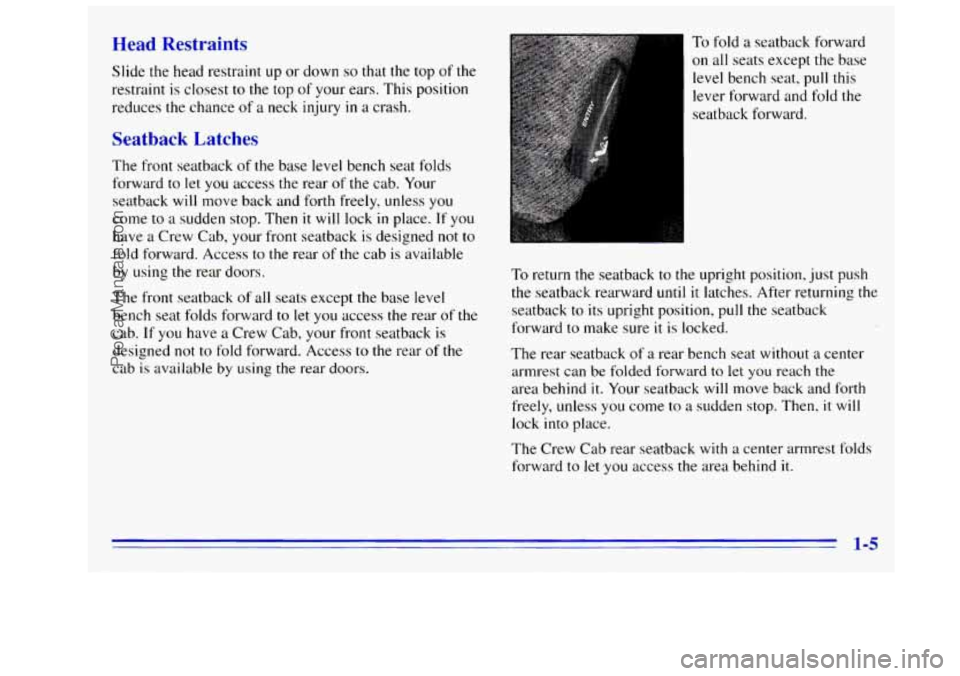Page 9 of 404

Section 1 Seats and Restraint Systems
Here you’ll find information about the seats in your
vehicle and how to use your safety belts properly.
You
can also learn about some things you should not do with
air bags and safety belts.
Seats and Seat Controls
This section tells you about the seats -- how to adjust
them, and fold them
up and down. It also tells you about
reclining front seatbacks and head restraints.
Mar--a1 Front Seat
CAUTION:
You can lose control of the vehicle if you try to
adjust
a manual driver’s seat while the vehicle is
moving. The sudden movement could startle and
confuse you, or
make you push a pedal when you
don’t want to. Adjust the driver’s seat only when
the vehicle
is not moving.
If your vehicle has a manual
bucket, split bench
or full
bench seat,
you can adjust it
with this lever at the front
of the seat.
~
I
Slide the lever at the front of the seat toward the
passenger’s side to unlock
it. Using your body, slide the
seat
to where you want it. Then, release the lever and try
to move the seat with your body
in order to make sure
the seat
is locked in place.
1-1
ProCarManuals.com
Page 13 of 404

Head traints
Slide the head restraint up or down so that the top of the
restraint is closest
to the top of your ears. This position
reduces the chance
of a neck injury in a crash.
Seatback Latches
The front seatback of the base level bench seat folds
forward to let
you access the rear of the cab. Your
seatback will move back and forth freely, unless
you
come to a sudden stop. Then it will lock in place. If you
have a Crew Cab, your front seatback is designed not to
fold forward. Access to the rear of the cab is available
by using the rear doors.
The front seatback of all seats except
the base level
bench seat folds forward
to let you access the rear of the
cab.
If you have a Crew Cab, your front seatback is
designed
not to fold forward. Access to the rear of the
cab is available by using the rear doors.
To fold a seatback forward
on all seats except the base
level bench seat, pull this
lever forward and fold
the
seatback forward.
To return the seatback to the upright position, just push
the seatback rearward
until it latches. After returning the
seatback
to its upright position, pull the seatback
forward to make sure
it is locked.
The rear seatback
of a rear bench seat without a center
armrest can be folded forward
to let you reach the
area behind it. Your seatback will move back and forth
freely, unless you come
to a sudden stop. Then, it will
lock into place.
The Crew Cab rear seatback with a center armrest folds
forward to let.you access the area behind
it.
ProCarManuals.com
Page 197 of 404

Do not load your vehicle any heavier than the
GVWR, or either the maximum front or rear
GAWR. If you do, parts on your vehicle can break,
or it can change the
way your vehicle handles.
These could cause you to lose control. Also,
overloading can shorten the life of your vehicle.
NOTICE:
Your warranty dose not cover parts or
components that fail because
of overloading.
If you put things inside your vehicle -- like suitcases,
tools, packages, or anything else
-- they go as fat as the
vehicle goes. If you have to stop or turn quickly, or if
there is a crash, they’ll keep going.
CriUTdN:
r
Things you put inside your vehicle can strike
and injure people in
a sudden stop or turn, or
in
a crash.
0 Put things in the cargo area of your vehicle.
Try to spread the weight evenly.
Never stack heavier things, like suitcases,
inside the vehicle
so that some of them are
above the tops
of the seats.
0 Don’t leave an unsecured child restraint in
your vehicle.
When you carry something inside the
vehicle, secure it whenever you can.
0 Don’t leave a seat folded down unless you
need to.
There’s also important loading information for off-road
driving
in this manual. See ”Loading Your Vehicle” in
the Index.
ProCarManuals.com